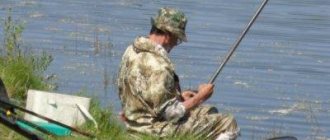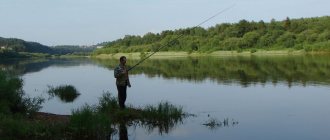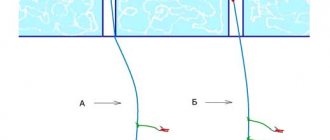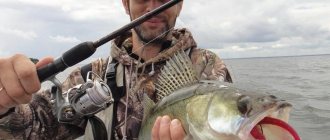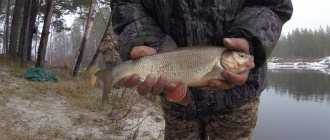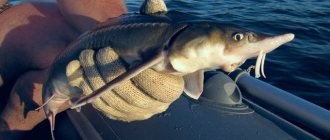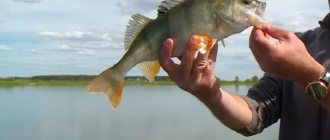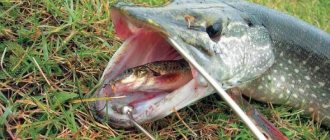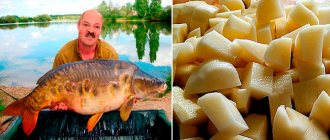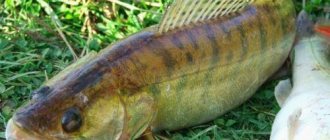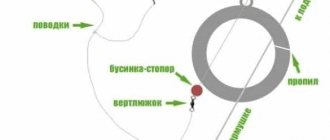Selecting and installing a fishing boat
Experienced fishermen most often use PVC boats for fishing with float rods. If the fish are very active, then any boat will do, but it is better to use an inflatable one. In currents, models with a length of 2.6 - 3 meters are best suited, maintaining good stability in the waves. A good option would be a boat with an inflatable chair of this type:
Since the fishing will be carried out with one float rod, we will use a minimum number of things: a fish tank, bait, baits, a small bag or box for spare equipment, a landing net and an anchor, and possibly a portable, wireless echo sounder. All this belongings will easily fit in a boat with the indicated dimensions. One person will be comfortable fishing in this case.
We will fish in the riverbed zone, so we pay special attention to the anchor. Often in such places at the bottom you can often find snags and trees carried by the current. It is best to find a more or less clean area and use a flag anchor of this type:
This design will avoid possible snags on the bottom. At the very least, their likelihood will be significantly reduced. To easily remove the anchor from the water, you need to tie a strong rope 20-25 meters long. It is better to attach a plastic bottle to one of the ends. When the anchor falls to the bottom, the boat will be carried away a little by the current, but then it will firmly stand in one place, since the anchor will rest against a small drop in the bottom. The bottle floats up, and you can use it to navigate where the anchor with the rope is.
If the current at the place where the boat is installed is significant, then use another weight. It is thrown in the opposite direction from the place where the first anchor fell. It is important that the distance from the boat to the two anchors is approximately the same, so that the boat is located in the middle.
Promising places for line fishing
It is best to choose an area where the strength of the current decreases, and the depth at the fishing site was about 4-5 meters. This way you can securely fix the boat and you can count on catching silver bream, bream, roach and crucian carp.
A very promising place would be a sharp bend in the river. We find an area near the riverbed with the depth indicated above and cast the echo sounder. With its help, we determine promising depth differences, edges, and generally see if there are fish in a given place. Ideal if you can find the edge. We will do the wiring along its lower part. We will determine the length of the wiring experimentally, depending on at what points the fish will bite. The distance from the boat to the point where the float is cast should be 5-6 meters. Here it is enough to get into the same zone, and then let the equipment swim a certain distance.
In general, finding good fishing spots from boats is not as difficult as it seems. On weekends, the riverbed zone in pressed-in reservoirs is occupied. On such days it is enough to outline a promising zone for yourself, and on weekdays, if possible, to fish.
Catching bream from a boat using a ring - Fishing with an onboard rod
Onboard fishing rods for catching bream from a boat are used in various designs. The rigging methods can be varied, but the rod itself should be:
1.7-2.5 m long;- unsinkable;
- light;
- flexible.
This rod is easy to handle in thickets and easy to hold in your hand for a long time. In the event of a strong bite, it will not break, but once in the water it will float up nearby. Since you can catch a large specimen from a boat, a weak rod with poor test will not withstand the load.
A variety of equipment is installed on the rod depending on the preferences of the fisherman. The following systems perform well in this capacity:
- float;
- nodding;
- bottom;
- feeder
Regardless of the chosen equipment option, catching bream from a boat with a fishing rod is practically no different. You need to monitor the bite alarm, and when it goes off, strike. The bait used is also identical. Since fishing takes place from a boat, the fisherman has a lot of options when choosing a place. If the bite is sluggish or absent, then you need to change the situation.
To increase the efficiency of catching bream with an onboard fishing rod, you can prepare a tackle with several hooks. One is equipped with animal bait, and the second with plant bait.
As a result, after several bites it will be possible to determine which of them is more catchy at a particular point. Since bream bites best from dawn to 10 a.m., there is practically no time to fish with ineffective bait.
The fisherman’s task is to quickly reconnoiter the situation and take advantage of the few hours of fish activity as efficiently as possible.
Fishing with wiring
Float tackle is often used not only for calm fishing with minimal mobility, but also for retrieving. This type of fishing is more productive. Retrieving from a boat is much easier, since you can swim to a clear place or current, where the likelihood of snags is reduced.
This method is most effective after the end of spawning in late May and early June.
On some reservoirs it can be used until the beginning of November. Reservoirs with weak currents are suitable for its implementation.
Swimming the boat to the place you like and throwing the anchor, you should set the depth on the float. The shipment should be minimal so that the current can gradually carry away the gear.
Too heavy a load will become an obstacle to wiring. The hook and bait must not be allowed to remain in the water column without touching the bottom. In this position, the bream almost does not take, and small bleaks and roaches will turn all their attention to the bait.
Casting should be done close to the boat, but not into its shadow.
The float will gradually move away under the influence of the current; periodically it is necessary to stop its movements and even return it a little. This is done by winding the reel or twitching the rod. As a result, the baited hook will drag along the bottom. Especially often, bream bite after twitching from the angler.
Fishing from a boat in this way is not difficult, especially if the rod has a reel. In order not to periodically repeat the cast, you can, when the float is completely removed, reel in the fishing line and return it to the edge of the boat. The fisherman is required to remain quiet and not make sudden movements.
When guiding along an uneven bottom with a light release of the float, it will float over the holes. At this point, the tackle becomes useless for catching bream, since the hook does not touch the bottom.
If possible, you need to select an even terrain with the same depth around the entire perimeter. But you should not fish shallows, because bream is practically not found in these places.
Equipping a float rod for fishing from a boat in the wire
We will use a 4-meter Bolognese rod with a reel. It is better to install a small inertia-free spool with a spool size of 2000. With its help, it is easy to change the length of the line and land large fish.
We wind a fishing line with a cross section of 0.2-0.22 mm onto the spool. We will install a float with a drop-shaped body, stable in the current, with a carrying capacity of 3-4 grams.
The optimal length of the leash is 25-35 cm. We install the hook No. 10. Fish in such places usually take the bait quite boldly, so there is no need to use small hooks. We attach one sinker - a sliding type. In front of the loop for attaching the leash, we install a rubber stopper to limit the movement of the weight.
Tackle for catching bream on line
A fishing rod for live fishing should be light and easy to grip in the hand, since it has to be constantly held suspended. It is equipped with a lightweight, inertia-free reel, which allows you to maneuver the tackle and release the hook with the nozzle over a fairly long distance downstream. Naturally, for better visibility, the float must have a high antenna. In addition to rafting with the current, there are additional techniques that can cause a sluggish bream or other “white” fish to bite. These are the so-called “holds”, during which the hook with the nozzle rises from the bottom, making movements similar to the game of a winter jig. Actually, a series of different techniques, which includes rafting with the current while hitting the bottom, holding the tackle, removing the equipment from the angler at a great distance, is the basis of autumn bream fishing, when passive tackle often only causes bites from ruffs.
Feeding a place for fishing from a boat
The best option for feeding the zone would be to use a metal cage with bait balls. We lower it to the bottom just above the current. We always throw the tackle next to the fish tank so as not to catch it with the hook. The food will be washed away by the current, creating a path along the edge. The bait will swim along this path. If the current in the fishing area is minimal, then periodically we take out the fish tank and move it a little so that the food is washed out faster. We make the balls of medium density so that on the one hand they do not disintegrate very quickly, but on the other they collect a little dust, creating an attractive cloud of turbidity.
The starter feed consists of 7-8 balls the size of an orange. Next, as they are washed out, we place 1-2 balls in the net every 30-40 minutes.
If the current in the fishing area is stronger, then the bait is weighted with clay or soil. The balls are rolled more densely to achieve uniform washout of the mixture. The amount of bait depends on the duration of fishing. If we fish for 5-6 hours, then 5 kg of the mixture will be enough. Moreover, the simplest one will do. You can mix 1 kg of crackers, 1 kg of flour and 1 kg of store-bought bait and add 2 kg of boiled millet. You can use 100 g as a flavoring. coriander or several packs of vanillin. It is better to moisten the mixture with water from the river.
The best baits would be maggot, worm, mastyrka, pearl barley and bread.
The process of fishing from a boat
After casting the bait into the desired place, they begin the actual fishing. First, make 10-20 casts to establish the points where fish bites most often occur. After casting, the reel bail is left open so that the bait swims a certain distance. It is advisable to avoid sagging, so as not to lose control of the nozzle. The farther the float goes, the closer we tilt the nod of the rod to the water.
Usually bites occur near the boat and near the net with bait balls. As a rule, the first fish that are caught on the hook are roach, silver bream and bream. Moreover, at first you come across small things, but soon larger individuals catch up, and more and more often you come across quite pleasant roaches and bream weighing from 300 grams.
If the bites stop for a while, it means that bream or large crucian carp, and possibly ide, have arrived at the point. At this time, you don’t need to make noise, but just wait for bites. Sooner or later, the big fish will start to act. After hooking, the bream usually stands still and you have to use a little force to drag it a meter or two. Then the clutch will work, and the rod will absorb the jerks of the fish, and you can bring it to the boat.
If you come across a large ide or chub, you will have to tinker a little. These fish can take the bait to a snag or other secluded place. After this, it is almost impossible to get them out of there. To keep the situation under control, you should tighten the clutch and forcefully keep the fish from trying to escape.
If there are no bites for a long time, then you can slightly hold the line with your finger. Pause for a few seconds and release the line again. Such manipulations are often followed by confident bites from roach and silver bream. During bites, it is advisable to make sharp but short hooks using a brush. If the hook is chosen correctly and it is sharp enough, then you can count on a high percentage of bites.
When using soft bread or semolina on the hook, the hooks should be made more smoothly. The tip of the hook will easily pass through the crumb and firmly stick into the lips of the fish.
If you manage to hook a large enough fish, it is slowly brought to the boat and taken on board with a landing net. No need to fuss about it. The main thing is to confidently perform all the actions in the correct order, and everything will be fine. It is advisable to use a landing net 3-4 meters long to catch fish a few meters from the side of the boat. This will be more convenient and safer.
It is not recommended to stand up during all activities. This position of the angler can frighten off cautious fish that stay on the bait table.
The success of fishing depends on the depth at which the bait swims. It is very useful to change the fishing depth in the absence of confident bites. It is also useful to use leaders of varying lengths with foam attached to the hook. A very effective technique would be small nods with the rod, during which the nozzle makes chaotic vibrations.
When fishing in strong currents, you can cast the rig a little further upstream and use a heavier weight and float. This increases the fishing time and maintains a good chance of catching fish. In such places, the nozzle is usually lowered into the bottom layer. The probability of bites is higher here.
To successfully fish from a boat, it is important to choose one or more places. After each fishing trip, you should throw away all leftover bait. In this way, it will be possible to accustom the fish to the place. If we see that there is a lot of coarse grains in a given place, then we add more coarse grains to the mixture - steamed barley grains, wheat, peas and canned corn.
Security measures
:Safety measures when fishing from a boat In the summer, happy owners of swimming equipment prefer to fish from a boat. Therefore, the issue of safety for these people is quite acute; following certain rules will not only help you avoid trouble while fishing, but even save your life.
- Let's start with the fact that when driving a boat, be very careful; even on a familiar body of water, there may be submerged logs, remains of old trees and bushes in the water.
- If you are fishing on a rubber boat, then be extremely careful, do not swim close to bushes and trees sticking out of the water, you can run into branches.
- Look carefully ahead when you are motoring, or even better, place a friend on the bow of the boat. At least it will signal you with established signals about any obstacle on the water, and tell you how to go around it.
- There may be underwater rocks on rivers and some lakes; certainly on taiga rivers and old northern lakes. In this case, it is better to use the services of local guides and fish on local boats, which are designed to pass rapids and are not afraid of underwater boulders.
- When fishing in an unfamiliar body of water, try to avoid swimming and especially without diving into the water. You don't know the bottom. You don’t know where, what snags and boulders may be located. Perhaps the bottom is heavily silted and sucks in instantly. Or perhaps at the bottom there is old construction waste with an abundance of iron structures and fittings.
- Even if you are hooked on a very expensive float tackle or spoon, do not get into the water. Everything you have in your hands is a consumable item, and you will buy more, but you only have one life. Remember: not a single one of yours, even the most expensive spoon, is worth a small cut on your heel, and as a result of this, ruined fishing, or worse, some kind of infection such as tetanus.
- It is very dangerous to go fishing on an old, leaky boat. If you don’t have any other means of swimming, but you really want to, then don’t swim far from the shore and have a water scoop with you.
- Do not lean on the side of the boat when fishing for fish or removing an anchor that is heavily embedded in the mud. You could lose your balance and easily end up in the water or scoop up water on the side of the boat.
- On the water, do not position the boat with its side facing gusty winds or along the waves. If the sides of your boat are not large, then the next wave may overwhelm and drown your boat.
- If there is a squally wind and a wave on the reservoir, do not take risks, swim out urgently. It will definitely rain soon, and perhaps there will be a thunderstorm. It is unknown how all this may end for your swimming device and, of course, for you. It is better to swim across the waves, even if further and not to the destination, but such a movement of the vessel is safer. Remember, it’s okay if you walk a few kilometers along the shore, it’s better than sinking the boat and having to swim yourself out of plan. And it’s easier later to move the boat to the right place in calm weather than now to get there by swimming on your own in terrible weather, but where you need to go.
- When choosing a place to fish on a large navigable river, pay attention to buoys, buoys and directional marks. Do not fish on the shipping route or main waterway. Remember that in deep water you need to be careful. And don't swim behind the buoys.
- If you do not know how to swim, then do not sail the boat far from the shore, and be sure to purchase a life jacket. All your comrades must know that you cannot swim. If, after all, the boat capsizes and you find yourself in the water, then do not try to climb into the boat, but, holding onto it tightly, try to swim to the shore. If you see that there are fishermen on boats at some distance, then do not be shy and call for help, or at least just shout. They will definitely help you.
- When fishing from a boat, do not forget to put an inflated balloon in your backpack with unused items or tie it to your backpack. Anything can happen. But your belongings and life support supplies will always remain afloat during camping conditions, and will not go under water or get lost.
- If you plan to fish on a large lake or bay, be sure to check the weather forecast. And always have with you a life jacket, a signal light, a signal cartridge or flare, a tow rope, a compass, a supply of high-calorie foods, a mobile phone or a radio station. And don't take risks if a storm warning is issued.
If the boat capsized
If suddenly the boat capsizes at a considerable distance from the shore and at great depth, then first it will lie on its side, and then turn over with its keel up. If there is no one nearby who can provide assistance, then, grabbing the stern or bow of the craft, paddling with your feet, swim to a shallow place or to the nearest shore. Never try to climb onto an overturned boat, as it will often capsize. Therefore, there is a risk that the boat will hit or cover the fisherman when doing so. If the boat capsizes on a river riffle or in a strong current, then you need to hold on to the boat and swim after it to a shallow place.
